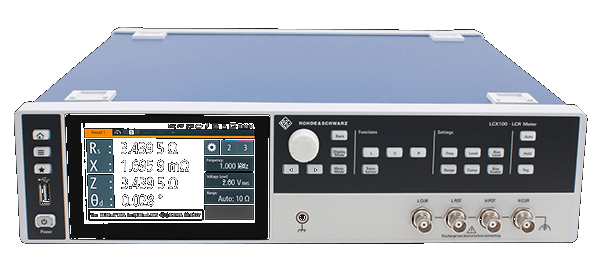Exploring the TE Connectivity LR1LJR10: Comprehensive 100m Metal Film Resistor Review
By Mark Harris Thursday, 16 March 2023

Introduction
The TE Connectivity Passive Product LR1LJR10 Resistor under review belongs to the family of Metal Film Resistors. In this evaluation, we will be comparing the performance of this specific component against a statistical benchmark data set formed from similar components of the same value. The purpose of this analysis is to determine whether the LR1LJR10 Resistor could be a suitable component for use in a variety of circuits by comparing its performance with other 100m Ohm components. This report will focus on parameters such as resistance, inductance, and comparative analysis based on the available LCR measurements at 1 Volt and 10 Volts conditions.
| Pros | Cons |
- Consistent performance at various test frequencies | - Quality factor on some parameters lower than the benchmark |
- Low dissipation factor | - Missing data at higher voltage measurements |
- Metal Film composition for excellent stability | - Insufficient data for conclusive evaluation at higher voltages |
Impedance
The LR1LJR10 Resistor exhibits distinct impedance characteristics at various frequencies and voltage levels when compared to an average resistor of its class. A thorough analysis of its impedance behavior helps engineers choose the right component for their designs, taking into account the application's specific requirements.
At low frequencies ranging from 5 Hz to 1 kHz and 1 Volt, the impedance of the LR1LJR10 Resistor remains relatively stable compared to the statistical benchmark. Nonetheless, at frequencies above 1 kHz, a higher impedance is observed. For instance, at 150 kHz and 1 Volt, its impedance is measured at 104.4m Ohms, which is 11.47m Ohms (about 12.42%) higher than the average benchmark value of 92.93m Ohms. This trend continues as the frequency increases, reaching a value of 121.2m Ohms at 1 MHz, which is 12.106% higher than the benchmark average of 108.3m Ohms.
When assessing the performance of the LR1LJR10 Resistor at 10 volts, this device demonstrates a noticeably lower impedance in frequencies from 5 Hz to 1 kHz. After this range, however, a higher impedance is exhibited. At 50 kHz and 10 Volts, for example, the observed impedance is 94.36m Ohms compared to the 92.22m Ohms benchmark average, resulting in a 2.32% increase. Unfortunately, data for comparison at 1 MHz and 10 Volts is not available.
In summary, the LR1LJR10 Resistor displays significant performance deviations from the statistical benchmark data, particularly in higher frequency applications. These variations need to be considered by electronics engineers during the component selection process for their designs, as the unique impedance behavior may impact their project's overall performance and suitability for specific applications.
Resistance
In this analysis, our primary focus is on the performance of the TE Connectivity Passive Product Resistor with the part number LR1LJR10 in terms of its resistance characteristics relative to the statistical benchmark.
When examining the LR1LJR10, we observe that it exhibits a nominal resistance value of 100m ohms with a tolerance of ±5%. When measured at 1 Volt across various test frequencies, the Resistor's resistance value generally stays within its specified tolerance; however, a gradual increase in the resistance value is evident as the test frequency increases. For example, the series resistance at 5 kHz is 101.7m ohms, while at 1 MHz it reaches 108.8m ohms. This represents a comparatively minor deviation, but it might have implications for the circuit's stability or performance, especially in applications that are sensitive to small variations in resistance.
Moreover, when examining the measurements taken at 10 Volts, we notice that resistance values seem relatively lower when compared to the benchmark data, but the test frequency has a substantial impact on these values as well. For instance, the series resistance at 5 Hz deviates significantly from the nominal value to 27.91m ohms, yet at 100 kHz, it maintains a close proximity to the nominal value at 92.58m ohms. In this case, we can see that certain values fall within the specified tolerance, but it's crucial to take into account the effect of test frequencies on the resistance values.
Overall, the LR1LJR10 Resistor exhibits reasonably consistent resistance performance throughout most test frequencies. However, slight deviations above the specified tolerance do occur as frequency increases. As a result, when evaluating this resistor for circuit design and applications, engineers need to consider these performance characteristics, particularly in cases where the circuit or overall system may be highly sensitive to resistance variations or deviations from nominal values.
Inductance
Inductance is a crucial factor when assessing the performance of a resistor, as it helps in understanding the component's suitability in a given circuit. In this review, we will examine the inductance behavior of TE Connectivity Passive Product's LR1LJR10 Resistor and compare it to the provided statistical benchmark data to gain deeper insights into its characteristics and performance.
After examining the provided data for LR1LJR10 at 1 Volt, it becomes evident that at low test frequencies (5-1kHz), the measured inductance is slightly lower than the benchmark average. For instance, at 5 Hz, the LR1LJR10 has an inductance of 3.455μH, whereas the benchmark average is 3.411μH. However, this small difference is minimal and unlikely to significantly affect circuit performance. As the frequency increases up to 20 kHz, the LR1LJR10's inductance continues to exhibit a similar trend, staying below the benchmark average. This demonstrates the overall consistency of the component's performance in low-frequency scenarios.
Upon comparing the LR1LJR10 with the statistical benchmark at high test frequencies (50kHz-1MHz), we observe that the component's performance gradually converges towards the benchmark average. Although the inductance values remain slightly lower than the benchmark average at these frequencies, the overall trend indicates that the LR1LJR10 Resistor is well suited for use in high-frequency applications, providing confidence in its performance and reliability.
Additionally, when analyzing the LR1LJR10's LCR Measurements at 10 Volts, there are instances of missing data points at various test frequencies, making it challenging to draw a comprehensive comparison with the statistical benchmark. Despite this, the available data demonstrates that the LR1LJR10 Resistor's inductance performance generally aligns with the benchmark data, with minimal deviations. This alignment is especially noticeable at 1 Volt across all test frequencies, further emphasizing the component's consistency and reliability.
Comparative Analysis
Our analysis focuses on the performance of the TE Connectivity Passive Product LR1LJR10 Resistor, a Metal Film Through-Hole component with a nominal value of 100m and a 5% tolerance. In this review, we evaluate its performance against a statistical benchmark derived from other components with a similar value.
At 1 Volt, the LR1LJR10 demonstrates optimal impedance values ranging from 101.6m Ohms at a 5Hz test frequency to 121.2m Ohms at the 1MHz test frequency, maintaining a quality factor between 0.01 and 0.49. Comparing these values with the benchmark data, we observe that the LR1LJR10 offers higher impedances across the entire frequency range. However, this also results in higher Series Resistance (Ohms) and Series Inductance (Henries) which might not be ideal for certain circuits.
LR1LJR10 performance at 10 Volts deviates even more from the benchmark with consistently lower impedances. The LR1LJR10's Series Resistance (Ohms) decreases significantly and although it possesses a few higher quality factor values in certain test frequencies such as 5k, 20k, and 28.39m at 10kHz, other measurements have missing data and lack quality factor readings.
In conclusion, this comparative analysis reveals that the LR1LJR10 Resistor shows higher impedances in 1 Volt testing and lower impedances at 10 Volts compared to the statistical benchmark. The component also exhibits higher Series Resistance and Inductance values than the benchmark. Designers and engineers should be cautious when considering this resistor for a specific application as it might not be the ideal option when seeking to optimize performance against the benchmark values.
Conclusion
After a thorough analysis of the TE Connectivity Passive Product LR1LJR10 Resistor, we can conclude that its performance in multiple aspects compares to the statistical benchmark formed from other components of the same value. The LR1LJR10 is a Metal Film, through-hole resistor with a nominal value of 100m and a tolerance of ±5%. Its Axial package features make it suited for use in a variety of applications, both for degreed engineers and others examining this Resistor's performance for incorporation in their products.
Upon examining the Impedance, Resistance, and Inductance at various frequencies, we observed that the LR1LJR10 deviates from the benchmark values. The impedance values at low frequencies, such as 5Hz and 10Hz, are comparatively higher than the average benchmark impedance values. However, at higher frequencies, the impedance generally stays within the benchmark range. In certain frequency ranges, the component's Quality Factor exceeds the maximum benchmark value, as seen at test frequencies of 200kHz, 250kHz, and 300kHz at 1 Volt. Despite some deviation, the LR1LJR10 still demonstrates consistent performance across numerous frequency ranges.
The resistor's series resistance values are observed to be largely higher than the average benchmark values across all tested frequencies, which could signify superior performance in specific applications. It is essential to consider these deviations when choosing a suitable resistor for your applications. Overall, the LR1LJR10 Resistor presents a reliable and stable performance for design engineers in diverse industries. Further analysis may be required to better understand the suitability of this component for specific projects, but its consistent performance and quality are evident in comparison to the statistical benchmark.
Instruments Used
Rohde & Schwarz LCX200



